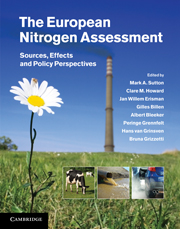Book contents
- Frontmatter
- Contents
- List of contributors
- Foreword
- Summary for policy makers
- Technical summary
- 1 Assessing our nitrogen inheritance
- Part I Nitrogen in Europe: the present position
- Part II Nitrogen processing in the biosphere
- Part III Nitrogen flows and fate at multiple spatial scales
- Part IV Managing nitrogen in relation to key societal threats
- Part V European nitrogen policies and future challenges
- 22 Costs and benefits of nitrogen in the environment
- 23 Developing integrated approaches to nitrogen management
- 24 Future scenarios of nitrogen in Europe
- 25 Coordinating European nitrogen policies between international conventions and intergovernmental organizations
- 26 Societal choice and communicating the European nitrogen challenge
- Glossary
- Index
- References
23 - Developing integrated approaches to nitrogen management
from Part V - European nitrogen policies and future challenges
Published online by Cambridge University Press: 16 May 2011
- Frontmatter
- Contents
- List of contributors
- Foreword
- Summary for policy makers
- Technical summary
- 1 Assessing our nitrogen inheritance
- Part I Nitrogen in Europe: the present position
- Part II Nitrogen processing in the biosphere
- Part III Nitrogen flows and fate at multiple spatial scales
- Part IV Managing nitrogen in relation to key societal threats
- Part V European nitrogen policies and future challenges
- 22 Costs and benefits of nitrogen in the environment
- 23 Developing integrated approaches to nitrogen management
- 24 Future scenarios of nitrogen in Europe
- 25 Coordinating European nitrogen policies between international conventions and intergovernmental organizations
- 26 Societal choice and communicating the European nitrogen challenge
- Glossary
- Index
- References
Summary
Executive summary
Nature of the problem
Reactive nitrogen (Nr) occurs in different forms, arises from a wide range of activities and sources, and leads to environmental impacts over different spatial and temporal scales.
Integrated approaches to N management are anticipated to provide more effective (larger decreases in unwanted emissions) and /or more efficient (less side effects, less costs) policy measures than policy measures based on single sources and pollutant species.
There are many notions of integrated approaches, but as yet little consensus about the best integrated approaches. There is also little quantitative empirical evidence of the performance of these approaches in practice.
The pitfall of integrated approaches is that they may be more complex to agree, leading to a delayed implementation.
Approaches
Based on recent literature and a discussion among experts, the present chapter provides a conceptual framework for developing integrated approaches to N management.
Whilst discussing the framework, various examples of existing partially integrated N management approaches have been considered.
A package of key actions in different sectors is envisaged that, together, should contribute to further developing integrated approaches to N management in the future
- Type
- Chapter
- Information
- The European Nitrogen AssessmentSources, Effects and Policy Perspectives, pp. 541 - 550Publisher: Cambridge University PressPrint publication year: 2011
References
- 6
- Cited by



